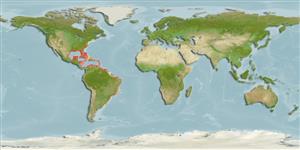Actinoptérygiens (poissons à nageoires rayonnées) >
Clupeiformes (Herrings) >
Clupeidae (Herrings, shads, sardines, menhadens) > Dorosomatinae
Etymology: Opisthonema: Greek, opisthe = behind + Greek,nema = filament (Ref. 45335).
Environnement / Climat / Gamme
Écologie
; marin récifal; profondeur 1 - 50 m (Ref. 93252), usually 5 - ? m (Ref. 9710). Tropical, preferred 25°C (Ref. 107945); 41°N - 37°S, 98°W - 33°W (Ref. 188)
Western Atlantic: Gulf of Maine (USA), Bermuda, throughout the Gulf of Mexico, Caribbean and West Indies southward to Santa Catarina, Brazil. The Colombian form is possibly a subspecies, Opisthonema oglinum captivai. Also found in Uruguay (Ref. 54736) and Argentina (Ref. 2806).
Length at first maturity / Taille / Poids / Âge
Maturity: Lm 11.5, range 11 - ? cm
Max length : 38.0 cm TL mâle / non sexé; (Ref. 5217); common length : 20.0 cm SL mâle / non sexé; (Ref. 188); poids max. publié: 375.00 g (Ref. 5217)
Épines dorsales (Total): 0; Rayons mous dorsaux (Total): 19-21; Épines anales 0; Rayons mous anaux: 23 - 24. The filamentous last dorsal fin ray distinguishes this species from all other western Atlantic clupeoids except Dorosoma, which has an inferior mouth (Ref. 188). Otherwise, superficially resembles species of Sardinella (but i 8 pelvic fin rays in western Atlantic species, cf. i 7 in Opisthonema) and Harengula (but small toothed hypomaxilla in upper jaw) (Ref. 188). Lower gill rakers stable at 28 to 46 after 8 cm (Ref. 188). Silvery, with a bluish or greenish back, 6-7 lengthwise dark streaks on side. Dark spot above opercle, larger dark spot behind opercle, usually with a row of dark spots behind it. Lower profile deeply curved. Head pointed (Ref. 7251).
Inhabit harbors and shallow coastal areas (Ref. 9710). Pelagic (Ref. 27549). Form schools (but solitary individuals reported), probably not entering water of low salinity. Feed by filtering plankton (copepods), but also take small fishes, crabs and shrimps. Marketed fresh, frozen and salted; also used in the fishmeal industry. Occur in freshwater in St. Johns River, Florida (Ref. 26938).
Possibly breeds in March-July off Venezuela.
Whitehead, P.J.P., 1985. FAO Species Catalogue. Vol. 7. Clupeoid fishes of the world (suborder Clupeioidei). An annotated and illustrated catalogue of the herrings, sardines, pilchards, sprats, shads, anchovies and wolf-herrings. FAO Fish. Synop. 125(7/1):1-303. Rome: FAO. (Ref. 188)
Statut dans la liste rouge de l'IUCN (Ref. 115185)
CITES (Ref. 94142)
Not Evaluated
Menace pour l'homme
Reports of ciguatera poisoning (Ref. 30911)
Utilisations par l'homme
Pêcheries: commercial; appât: usually
Outils
Articles particuliers
Télécharger en XML
Sources Internet
